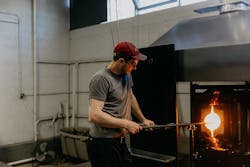Creating Unique Glass Lighting Fixtures With Hennepin Made
Watch their process in the video ►
Jackson Schwartz and Joe Limpert founded Hennepin Made in 2011, when they partnered with the common belief that handmade products have an essential place in our culture and everyday life. The two create lighting and other modern glass designs for retailers and designers.
Hennepin Made's facility has a unique set up - in addition to the glass production portion of the building, the 30,000-square-foot warehouse is also home to a café called Parallel, an event space and retail lab.
Parallel's design incorporates dozens of Hennepin Made's lights throughout the bright and airy space, and features other key elements like Cambria's Rosedale quartz for the cafe's countertop, which is comprised of a playful ombré pattern.
Each day, Hennepin Made employees make anywhere from 20-80 lights depending on the fixture's pattern, which currently adds up to 10,000 lights a year. Learn more about the studio and its journey in this Maker Monday installment below.
Interiors+sources: How did you get your start?
Jackson Schwartz: We started our studio by renting a small space in a warehouse and assembling some used glass production equipment from eBay and craigslist. We built out the rest of studio and started blowing glass within a couple months. From there it was just small consistent steps to keep building our product collection and capabilities.
i+s: What inspires you?
JS: What inspires me is having a strong vision for craft/design and then developing the team to make it a reality. I think there is a tremendous amount of opportunity in scaling our studio through manufacturing while still being true to craft.
i+s: What is your most memorable product or collection you’ve worked on and why?
JS: Our Parallel Series was the first collection that brought different materials together. The tops are handspun aluminum and there was a lot to learn about that process. Aesthetically, I think the collection will have longevity. The forms are fluid and are very adaptable into many different types of spaces.
i+s: Describe what a typical work day for you looks like.
JS: My morning usually starts with an espresso in our café, Parallel. This morning period is where I can work on design and get some problem solving in before the day gets busy. From there I move into meetings with different team leaders. We work through custom projects, product development, and see how we are tracking on our development goals. I check in with our glass production to see how things are going.
Most days I have a lunch meeting or tour with a possible partner or community relationship we are looking to build. We work a lot with other design companies on collaborations to help market one another.
i+s: Name some must-haves you need or like to have on-hand when starting a new project.
JS: The right people are essential. If you don’t have the team set up and everyone invested, you are not starting out in the best direction. It is also essential to have enough time and space for the exploration phase. We need to explore options before deciding on a direction. There is usually a tight enough scope that we generally know what we want to accomplish, but still leave a good portion of the possible outcomes undefined.
i+s: What challenges you most during your creative process?
JS: Keeping momentum when pulled in different directions. As the leader of the studio and business, you have to maintain a pulse on all aspects of what we do. If you get too focused on just one project or design, the overall health of the studio will suffer. So you have to move in and out of teams and projects fluidly and be creative in pretty much everything you touch.
i+s: What is your favorite thing in your working environment?
JS: We are for the most part all artists. It makes for a dynamic place to work. Everyone is engaged with their work and likes helping one another. There is a general attitude that what we are creating matters and is important.
i+s: What’s your favorite color?
JS: That is a mood question, so I wouldn’t be able to pick just one. I think designing lighting pushes you to think about how color plays with our environment since light can have such a large impact on a space and, in turn, how we engage in that space.
i+s: What is your favorite design era?
JS: Now.
Related: NEED-TO-KNOW TRENDS FOR 2018
i+s: What do you think is next for the interior design industry?
JS: I think exploring the intimacy of space; we already see this happening with re-defining what “social” means. We opened a café in our building and there are so many types of activities happening in there throughout a day.
We have morning people who come get a coffee and read the paper. We have business meetings, breakout brainstorming sessions, gig economy workers with their headphones in, the neighborhood lunch crowd, people shooting photos for social media, people recording interviews for podcasts, networking social hours, etc.
My observation is that people want to be around other people to feel like they are part of a social environment, but don’t necessarily need to be sharing with all the people in a space. There is an energy that people want to be a part of and I think interior design is the tool to activate that.
i+s: What advice would you give to students studying the design field?
JS: Learn the business of design and build relationships with mentors. Students should imagine early on how they can navigate their path in field. Then you can check in from time to time and see if you need to shift or reassess on where you are at.
i+s: What’s next for you?
JS: We have just finished our onsite retail store, so [we] keep building that offering with accessories and drinkware. Additionally, we are exploring new possibilities in LED technology for our next round of lighting collections.
About the Author

Adrian Schley
Associate Editor
Adrian Schley was an Associate Editor for i+s, where she covered the commercial interior design industry since 2018. Her work can also be found in BUILDINGS and Meetings Today.
